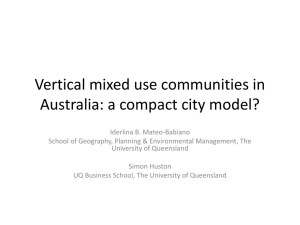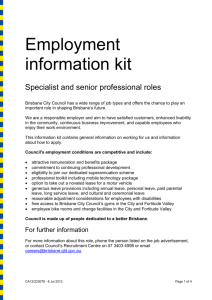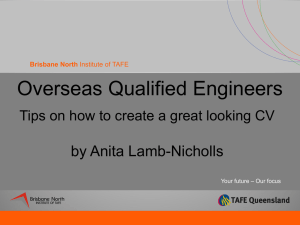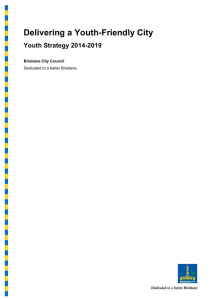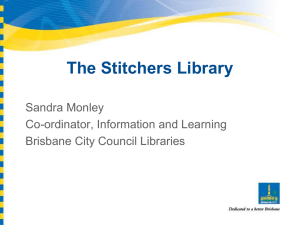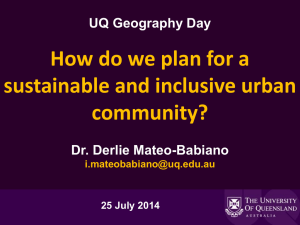River`s Edge Strategy 2013
advertisement
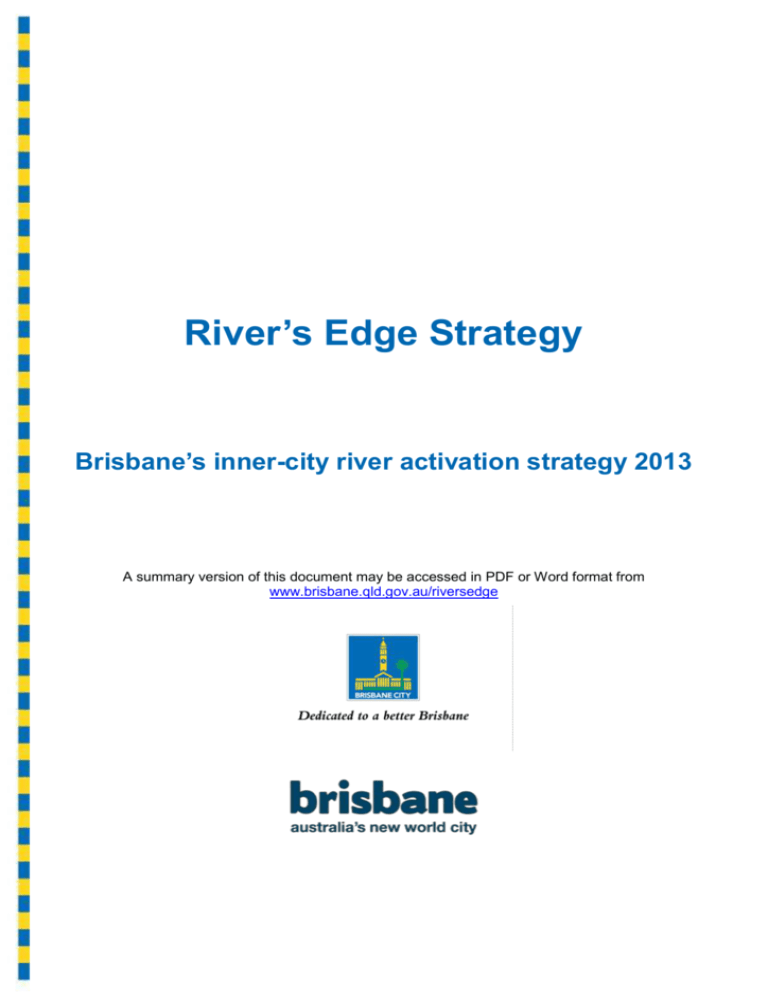
River’s Edge Strategy Brisbane’s inner-city river activation strategy 2013 A summary version of this document may be accessed in PDF or Word format from www.brisbane.qld.gov.au/riversedge Lord Mayor’s Foreword The Brisbane River is our city’s greatest natural asset and its meandering reaches are a defining feature of our inner-city’s identity. Over the last two decades, the inner-city reaches of the river have evolved from working industrial waterfronts to vibrant and prosperous mixed-use riverside communities. As Brisbane continues to develop as Australia’s new world city, we are presented with even more opportunities to increase the way we use our river and its edges. As a river city with an enviable subtropical climate, we need to capitalise on this unique natural landscape feature to showcase our city to residents and visitors alike. In 2011 I launched Brisbane’s Unique Window of Opportunity, a strategy aimed at driving long-term economic growth in Brisbane. This report identified the need for Council to provide opportunities for visitors, residents and business to make better use of the Brisbane River for tourism, recreation and enjoyment. The report also outlined the clear role that Brisbane businesses can play in providing a diverse range of activities along our river’s edge. Council is committed to addressing the needs identified in this report, and the development of the River’s Edge Strategy is one of the ways we plan to achieve this. At Riverfire last year, I launched the community consultation for the River’s Edge Strategy. Throughout October 2012, more than 2000 people told us how they currently use the river and shared their ideas on what aspects they would like to see improved. Council used these ideas to produce the draft River’s Edge Strategy. During June 2013, Council sought public feedback on the draft River’s Edge Strategy. The majority of potential projects proposed in the draft strategy received overwhelming support. The potential projects that received the most interest were: cross-river pedestrian and cycle connections RiverLink pedestrian and cycle links between major commercial and residential areas and the river riverside eating and drinking precincts urban zip line (flying fox) from Kangaroo Point to the CBD RiverLoop jogging, walking and cycling loops extension of the RiverWalk network. The feedback on each of the potential projects has been invaluable in helping Council shape the River’s Edge Strategy. Successful implementation of the River’s Edge Strategy relies on Council working together with the Queensland Government, businesses and the community over the next 10 years. In the immediate future, Council will be seizing opportunities to implement the strategy, and is open to new ideas from business and the community to help enliven our river. This is a strategy for all of us – Council, residents, businesses and tourists – and will guide how we plan for, use and manage the Brisbane River into the future. By working together, we can achieve great outcomes for our city’s future. Graham Quirk Lord Mayor of Brisbane Table of contents Lord Mayor’s Foreword.......................................................................................................................... 2 Table of contents ................................................................................................................................... 3 Overview ............................................................................................................................................... 4 About the strategy.............................................................................................................................. 4 ‘About the strategy diagram’ description ......................................................................................... 4 Vision .................................................................................................................................................... 4 Strategy highlights ................................................................................................................................. 5 Project snapshots .................................................................................................................................. 6 Implementation ...................................................................................................................................... 6 Introduction ........................................................................................................................................ 6 Flow chart description .................................................................................................................... 7 Projects, Opportunities and Strategy Wins ......................................................................................... 8 Transformative projects table ......................................................................................................... 8 Strategy wins table ......................................................................................................................... 8 Immediate opportunities table ........................................................................................................ 9 Place ................................................................................................................................................... 10 Key outcomes .................................................................................................................................. 10 A world-class identity.................................................................................................................... 10 An economic driver....................................................................................................................... 10 A flexible space ............................................................................................................................ 10 A place for everyone .................................................................................................................... 10 Potential projects ............................................................................................................................. 10 Play ..................................................................................................................................................... 12 Key outcomes .................................................................................................................................. 12 An active river’s edge ................................................................................................................... 12 A water playground ...................................................................................................................... 12 A stage for events ........................................................................................................................ 12 Potential projects ............................................................................................................................. 12 Connect ............................................................................................................................................... 14 Key outcomes .................................................................................................................................. 14 A connected river ......................................................................................................................... 14 A people mover ............................................................................................................................ 14 Potential projects ............................................................................................................................. 14 Enable ................................................................................................................................................. 16 Key outcomes .................................................................................................................................. 16 A river brand................................................................................................................................. 16 A well-managed river.................................................................................................................... 16 A place we all know ...................................................................................................................... 16 Potential projects ............................................................................................................................. 16 Map of selected potential projects ....................................................................................................... 18 Implementation example ..................................................................................................................... 19 Relationship to other Council strategies .............................................................................................. 21 Brisbane’s Unique Window of Opportunity Report ........................................................................... 21 Brisbane Economic Development Plan 2012-2031 .......................................................................... 21 Brisbane Long Term Infrastructure Plan 2012-2031 ......................................................................... 21 Planning strategies .......................................................................................................................... 21 Brisbane’s FloodSmart Future Strategy ........................................................................................... 21 WaterSmart Strategy ....................................................................................................................... 22 Transport Plan for Brisbane ............................................................................................................. 22 Active Transport Strategy ................................................................................................................ 22 Publication information ........................................................................................................................ 22 Overview About the strategy The River’s Edge Strategy supports a vision for the inner-city reaches of the Brisbane River, and will complement existing strategies that relate to the river and its use. The strategy consists of four themes - Place, Play, Connect and Enable - that relate to the way we deal with the river and its edges. Key outcomes help to build a picture of each theme and guide decision making for river and riverside spaces, activities, connections, promotion and management. To realise these outcomes, we are proposing potential projects. These are projects that could be implemented by Council, Queensland Government, community organisations, businesses, or the general public. These matters are dealt with by other Council strategies. Refer to page 32 for further information on these strategies. ‘About the strategy diagram’ description Diagram about the River’s Edge Strategy outlining what the strategy is and isn’t. The strategy is: a framework for planning and decision making a strategic guide for Council, businesses and the general public a suite of potential projects that could be implemented in the short, medium or long term by Council, Queensland Government, businesses or the general public to promote the river as a recreational, tourism and economic asset. The strategy is not: a statutory plan detailed advice on specific locations or projects a financial commitment to undertake every project. The strategy does not manage flooding improve river health plan for car-based transport and car parking. Vision The inner-city reaches of the Brisbane River are a distinguishing feature of our city’s identity and a major focus for business, tourism and leisure. The river and its edges are inviting places that are accessible to everyone: locals and tourists, individuals and groups, children and adults. Riverside parks, places and paths are destinations open for all to experience for fitness, feasting and festivities, where people go for play, reflection and connection to nature. The river is celebrated as an economic opportunity by businesses and enterprise where it is possible to realise ideas, from humble to visionary. It is the focus for the city and connects and integrates neighbourhoods, institutions and businesses. All stakeholders work together to enable the river to become a world-class destination for both work and relaxation through careful planning and policy. Strategy highlights The strategy identifies 12 key outcomes for the inner-city reaches of the Brisbane River and groups these under four themes – Place, Play, Connect and Enable. The themes provide the basis for more specific key outcomes to achieve the vision, and also provide further direction on how the river and its edges should be planned for and managed. A range of potential projects that will assist in achieving these key outcomes are identified in the following pages. The potential projects are identified under the following classifications: Transformative projects - Major projects that can make a significant contribution to Brisbane’s continued evolution as a river city. Immediate opportunities - Easily implementable projects that can make a fast and cost-effective contribution. Strategy wins - Projects that can contribute to achieving the key outcomes of this strategy. These projects could be implemented by government, business and the community. Project snapshots These are just a few potential projects to represent the four themes of the River’s Edge Strategy. See the following pages for more information and the full range of potential projects identified. Riverside eating and drinking precincts Network of non-motorised watercraft launch and short-term mooring sites Network of short-term mooring sites for recreational vessels RiverStop places for public access to and enjoyment of the river Lighting of major riverside parks and paths RiverHub - consolidated public marina and tourist boat terminal World-class sporting events RiverWalk pedestrian and cycle network Comprehensive information and mapping Review regulatory framework Implementation Introduction Implementation of the River’s Edge Strategy is a shared responsibility between government, business and the community. The strategy’s success requires a combined effort to bring the expertise together to achieve the best possible outcomes in the fastest time. This strategy is intended to inform: Council’s thinking and planning for inner-city river related projects and issues, through the creation of strategic planning documents, new policy and statutory plans and in the planning and delivery of capital works projects Businesses (including tourism operators) and community organisations about opportunities to increase use of the river. Planned outcomes of the strategy will be progressively implemented by both Council and businesses as part of the city’s continued growth. The strategy identifies a series of specific potential projects that will contribute to achieving the planned outcomes of the strategy. This is not a comprehensive list, however, and Council welcomes discussion with business, community members and the general public about potential projects that fit with the vision and themes of the River’s Edge Strategy. The flowchart overleaf provides information on how you can be involved in the implementation of the strategy. Flow chart description Flow chart titled ‘River’s Edge Strategy September 2013. The first bubble says “I have an idea that I’d like to discuss with Council / I’d like to help implement the River’s Edge Strategy” and it leads to a bubble that says “Ideas and Implementation”. This bubble is connected to two different subordinate bubbles, the first says “Expressions of interest for projects (e.g. use of community buildings for riverside food and beverage outlets)” and the second says “Implementation through business or community initiatives”. Both bubbles lead to an instruction to contact Council on (07) 3403 8888 or via the Business Hotline on 133 BNE (133 263). Projects, Opportunities and Strategy Wins The following tables identify estimated timeframes for planning and delivery of the potential projects identified in this strategy. Many of the projects lend themselves to staged delivery over time as funding allows, and some could be commenced immediately. Transformative projects - Major projects that can make a significant contribution to Brisbane’s continued evolution as a river city. Immediate opportunities - Easily implementable projects that can make a fast and cost-effective contribution. Strategy wins - Projects that can contribute to achieving the key outcomes of this strategy. Transformative projects table Transformative Projects Short term Medium term Riverside eating and drinking precincts Yes Yes Network of non-motorised watercraft launch and short-term mooring sites Yes Yes Long term Yes Urban flying fox (zip line) Yes CBD riverside public lap swimming pool Yes Yes Yes Three pronged-approach to cross-river pedestrian and cycle connections Yes Yes RiverHub - a new consolidated public marina and tourist boat terminal Yes Yes Network of short-term mooring sites for recreational vessels Yes Yes Yes Cross-government and major stakeholders working group Yes Long term Strategy wins table Strategy wins Short term Medium term Walking and cycling trails exploring key themes of our river Yes Yes Community art spaces for temporary outdoor exhibitions Yes Themed feature lighting Yes Yes Yes Riverside public art program Yes Yes Yes Yes Yes Yes Yes Yes RiverStop places for public access to and enjoyment of the river Urban outdoor sports centre Inter-suburban and inter-school river recreational events Yes Yes Stage for events Yes Yes World-class sporting events Yes Yes Boat ramps RiverWalk pedestrian and cycle network Yes Yes Yes Yes Yes Immediate opportunities table Immediate opportunities Short term Medium term Lighting of major riverside parks and paths Yes Yes RiverRest places for quiet reflection and enjoyment of river views Yes Yes Mobile food and drink vendors in riverside parks and public spaces Yes Diversity of river edge treatments Yes Yes RiverParks program Yes Yes A series of off-river routes linking RiverWalk segments (RiverConnect) Yes Yes Jogging, walking and cycling loops (RiverLoops) Yes Yes Network of improved pedestrian and cycle links from major commercial and residential areas and bus and rail stations to the river (RiverLink) Yes Yes Encourage visitors using the CityCat and CityHopper to hop off at riverside destinations Yes Promote simple RiverResponsibilities Yes Comprehensive information and mapping Yes Yes Review regulatory framework Yes Yes Reveal the river’s lesser-known places Yes Yes Long term Yes Yes Yes Place Brisbane is the river city. Our river is a defining element of our city’s identity. It shapes how we move, where we live and how we celebrate, and features in much of Brisbane’s history. Transformed from an industrialised urban waterway over the last 20 years, it flourishes as a focus of life, business and recreation in Brisbane. The river and its edges are welcoming and attractive, anchoring Brisbane’s inner-city communities in a diverse and distinctive chain of urban places and open spaces. Key outcomes A world-class identity The river is Brisbane’s natural icon and the setting for many of our city’s business, leisure and tourism attractions. We seize opportunities to create world-class waterfront places, postcard vantage points, parks, and pathways, that capture the river experience. An economic driver Riverfront spaces draw people in, because of their diversity of recreational, entertainment and tourism opportunities. Redevelopment of riverfront sites provides new opportunities to engage with the river and ensures that the river and its edges remain at the heart of Brisbane’s economy. A flexible space A network of riverfront spaces is designed to be flexible, practical and flood resilient. They provide the setting and facilities for an extensive array of activities that enable people to experience the river and enliven the water with activities. A place for everyone Public spaces, streets and new developments are safe and accessible both day and night, and are designed to reflect our rich riverfront history, both indigenous and European. River frontage in public ownership is carefully planned to provide a range of opportunities for access to the river for the public and community organisations. Potential projects Transformative projects: Create riverside eating and drinking precincts in local communities along the river (possible locations include St Lucia, Teneriffe, West End and Yeronga). This could include using existing riverside buildings such as those in active recreation community lease areas. Introduce a RiverParks program to: o Review the level of park facilities needed to support the projects identified in this strategy – including water bubblers, BBQs, bins, toilets, shelter, seating, exercise equipment and directional signage for vistas. o Identify parks suitable for temporary events such as pop-up festivals showcasing up-andcoming performers, outdoor theatre, floating stages, or weekly evening fresh food markets. Maintain and promote a diversity of river’s edge treatments that offer different experiences and opportunities to access and enjoy the river, including: o grass (e.g. South Bank River Quay) o natural beaches (e.g. Captain Burke Park) o mangroves (e.g. Gardens Point) o rocky outcrops (e.g. Kangaroo Point cliffs park) o RiverWalk (e.g. Teneriffe). Immediate opportunities: Facilitate exercise and casual relaxation along the river in the cool of the evening and early morning by improving lighting of major riverside parks and paths. Establish a network of small RiverRest places for quiet reflection and enjoyment of river views by the public in reaches of the river where the river’s edge is predominantly privately owned. These places provide an opportunity to connect with nature, and have only a basic level of facilities, such as seating, water bubblers and bins. Proposed RiverRest places are shown on the map on page 28, and an additional RiverRest place is to be considered in Highgate Hill or St Lucia. Create opportunities to buy food and drink from mobile vendors in riverside parks and public spaces, starting with the Park Bites trial in Captain Burke Park, the City Botanic Gardens, Kurilpa Point Park and Orleigh Park; and the refreshment pod on the Bicentennial Bikeway (as shown on map on page 28). Strategy wins: Provide community art spaces for temporary outdoor exhibitions along the river. Highlight the diverse character of our river’s edge through a series of walking and cycling trails exploring key themes of our river including: o Indigenous story of the river o significant natural features o colonial history. Celebrate the river with themed feature lighting in key river locations. Expand the riverside public art program in key riverside locations of high pedestrian activity or cultural or natural significance. Did you know factoid Many of Brisbane’s significant cultural facilities are located on the river and can be accessed by the CityCat and RiverWalk networks. The cultural precinct at South Bank offers performing and fine arts, the State Library, Queensland Museum and Science Museum. Customs House on the Town Reach hosts regular Sunday concerts by university students, the Brisbane Powerhouse at New Farm maintains a yearround program of events and performances, and the Brisbane Jazz Club provides live jazz in a riverfront setting. Brisbane’s cultural heritage is celebrated at the William Street heritage precinct centred on the Commissariat Store. Play The river is full of life, as a stage for a broad range of recreational, cultural and tourism activities and events. From organised sport and community life to play and passive relaxation, both the river and its banks play a critical role in providing for our recreational needs and community health. The river is the premier venue for cultural events and tourism that shines a light on Brisbane as a world-class destination and one of Australia’s most scenic and liveable cities. Key outcomes An active river’s edge The river’s edge is alive with activity, both day and night. A full range of civic, sporting, recreational and entertainment activities is possible in our public open spaces, urban places and parks, to support a healthy, active city and to reinforce Brisbane as a great tourism destination. A water playground The river is animated with boating and water-based sport and recreational activities that are supported by the necessary land-based and in-river infrastructure and amenities. Tourists and visitors are welcomed to the river’s edge and onto the river to enjoy a unique experience. A stage for events The river and its edges are the stage for cultural events, including small-scale and pop-up events that provide an element of surprise for locals and visitors and encourage people to re-connect with the river. The river and adjoining places and spaces create new opportunities for an assortment of events that showcase our active and healthy lifestyle and subtropical city. Potential projects Transformative projects: Investigate a CBD riverside public lap swimming pool to complement the highly successful South Bank beach. This project is included in Council’s City Centre Master Plan. Establish a network of non-motorised watercraft launch and short-term mooring sites to support use of the inner-city reaches of the river by kayaks and similar craft, and access to key points of interest including commercial centres and major public spaces. Investigate opportunities to support this initiative with: o land-based amenities for non-motorised watercraft users (such as storage lockers and showers) o a multiple site short trip kayak hire scheme. Support the growth of urban adventure activities on and near the river by investigating a privatesector delivered urban flying fox (zip line). This activity is most suited to locations in or adjacent to the CBD, such as across the river from the Kangaroo Point Cliffs to the City Botanic Gardens. Strategy wins: Launch a network of innovative RiverStop places for public access to and enjoyment of the river. These places provide a variety of functions specific to each site, including features such as fishing platforms, shaded river viewing areas, multi-use spaces for temporary activities and short-term moorings for non-motorised watercraft. RiverStops are carefully designed to avoid conflicts with the RiverWalk, CityCats and nearby activities. Possible locations include the Bicentennial Bikeway at Milton and Hawthorne/Bulimba. Investigate an urban outdoor sports centre at Queen’s Wharf under the Riverside Expressway, incorporating activities compatible with the noise and space limitations of this area. This project is included in Council’s City Centre Master Plan. Support Brisbane residents’ active and healthy lifestyles by establishing inter-suburban and interschool river recreational events. These community-based events could include regattas or landbased multi-sport events and would facilitate community building and open up opportunities for a range of river activities. Promote the river as an important stage for events, by supporting the establishment of temporary activities such as: o floating stage/cinema o riverside pop-up festivals showcasing up-and-coming performers o riverside outdoor theatre o water-based shows. Introduce world-class sporting events that celebrate the diverse experiences that Brisbane’s innercity river offers and attract visitors to our city. Multi-activity events would represent a unique attraction for our city, and could take advantage of the: o river for water-based activities including rowing, kayaking, sailing and dragon boating o riverside paths for land-based activities including running and cycling o Kangaroo Point Cliffs for adventure activities. Key Achievements factbox Brisbane was the host for World Expo 88, a six-month world fair set on a stretch of former industrial land on the South Brisbane reach of the Brisbane River. The theme Leisure in the Age of Technology was celebrated as the river came alive with activity, from water skiing and high-tech light shows to night parades and street vendors on the adjoining riverbank. This event transformed the way Brisbane residents saw this stretch of the river and encouraged new lifestyle opportunities like outdoor dining and night-time riverside events. Expo also became the major catalyst for the creation of the South Bank Parklands, a 17-hectare riverfront open space featuring excellent recreational and leisure activities such as a swimming pool and beach, riverside promenade and restaurants. Twenty-five years later, major events such as Riverfire continue to draw people to the river’s edge, and now the River’s Edge Strategy is poised to kick-off the next stage of Brisbane’s evolution as a river city. Connect Rather than being perceived as a barrier, the river and its banks become one of the city’s most important corridors and connectors. Increased active transport along, across and to the river opens up new opportunities and helps connect riverside communities. Water taxis, private boating, tourism operators and non-motorised watercraft supplement the existing river transport system in a way that stitches together our most valued and popular destinations. Key outcomes A connected river The river and its edges are the threads that pull together a diverse network of urban centres and open spaces. People are drawn to the river by the high-quality public space, ease of travel and links to areas where people live and work. A people mover River-based transport is part of Brisbane’s unique lifestyle experience and public, private, and tourist operators provide a variety of river transport options. Potential projects Transformative projects: Draw Brisbane communities together with a three-pronged approach to cross-river pedestrian and cycle connections. o Public transport: enhance the iconic CityCats, CityHopper and CityFerry services, including the construction of the Milton Ferry Terminal. o Private active travel: in partnership with Queensland Government develop additional bridges for pedestrians/cyclists/buses in high travel demand areas (as shown on map on page 28). o Commercial transport: facilitate the establishment of water taxi services for o on-demand passenger transport across and along the river. Enable pick up/drop off access to selected ferry terminals, where this does not interfere with ferry operations. Open up new river experiences by establishing a network of short-term mooring sites for recreational vessels enabling travel by private boats to key points of interest including commercial centres and major public spaces. Investigate a RiverHub - a new consolidated public marina and tourist boat terminal in the innercity that could cater for a range of small and large recreational vessels and tourist/charter boats. Possible locations could include North Quay, Howard Smith Wharves, the CBD bank of the Town Reach, South Bank or South Brisbane (as shown on map on page 28). Immediate opportunities: Introduce RiverLink – a network of improved pedestrian and cycle links from major commercial and residential areas and bus and rail stations to the river, including clearly marked themed signage highlighting proximity to the river and the best routes. Strategy wins: Expand the RiverWalk pedestrian and cycle network along the river (as shown on map on page 28). Construction of the following key links to be led by government: o Howard Smith Wharves and replacement RiverWalk to Merthyr Road, New Farm o Kingsford Smith Drive, Hamilton o Maritime Museum link between South Bank and Lower River Terrace (subject to further investigation) o Bulimba Riverside Park. Construction of the following links to occur incrementally as part of any redevelopment: o Northshore Hamilton o Commercial Road to Newstead Riverpark o Mowbray Park to Cairns Street, Kangaroo Point o Byron Street, Bulimba o Bulimba Barracks. Develop additional boat ramps near the edge of the study area where there is sufficient space for the associated access infrastructure, such as The Corso and Bulimba. Did you know factoid The 1999 RiverWalk Strategy was a bold plan to provide a network of riverfront pathways along the Brisbane River from Teneriffe and Bulimba to West End and Toowong. Approximately 14 kilometres of RiverWalk has been delivered through a combination of riverfront site redevelopment and Council-funded projects, significantly improving public access to the river (refer to map on page 28). Did you know factoid The river is a dominating feature of the inner-city and in some reaches is as wide as 480 metres. The meandering nature of the river is one of its defining characteristics but also presents a barrier between its northern and southern banks. River crossings in Brisbane have traditionally been focused on moving vehicles to and from the CBD via bridges, but in recent times have evolved to cater for a variety of transport modes including walking and cycling. Continued development of cross-river connections will create new links between communities, open up opportunities for easy access to recreation, entertainment and public transport on the opposite bank, and reduce the need to replicate infrastructure on both banks of the river. Enable The river and its edges have a clear identity that is promoted consistently. Strong promotion and easily accessible information about the river enables residents, visitors and business to maximise their experience of the river and its opportunities. The diversity of activities on the inner-city reaches of the river and its edges means there are many people with an interest in this space and a diversity of user groups. Despite the numerous authorities involved in river planning and operations, management of the inner-city reaches of the river occurs in a coordinated, integrated and collaborative manner. The successful coordination of different levels of government, interest groups and operators reduces red tape and facilitates projects, and therefore is key to unlocking the river’s potential. Key outcomes A river brand Places and spaces along the inner-city reaches of the river have a distinct identity that is clearly communicated to visitors and residents and promotes the river and what it offers. A well-managed river State and local government collaborate with key stakeholders to ensure a coordinated, efficient and timely approach to the development of river-related policy initiatives and implementation of the River’s Edge Strategy projects by government, business and the community. A place we all know Residents and visitors are aware of available opportunities on and near the river. They can easily and quickly find information to help them discover, explore and enjoy everything from lesser-known places to iconic spaces. Potential projects Transformative projects: Continue the Brisbane River Working Group, a cross-government and major stakeholders working group to develop policy initiatives along the river and provide strategic advice for implementation of this strategy. Immediate opportunities: Promote simple RiverResponsibilities to help river and RiverWalk users to enjoy the river harmoniously. This could address aspects relating to noise, environmental obligations, and awareness of other users and activities, and build on the Brisbane River Code of Conduct endorsed by Rowing Queensland, Maritime Safety Queensland, Brisbane Ferries and Brisbane City Council. Review regulatory framework to ensure that appropriate proposals on the river can proceed in an efficient timeframe, while ensuring that flooding, environmental and design matters are fully addressed. This includes reviewing the approval process for infrastructure and other works below the high water mark and consolidating the tenure and management of riverside parks and public spaces. Launch comprehensive information and mapping that link in with the Brisbane River identity and showcase elements of this strategy, utilising a range of digital and print media and foreign language signage. Some examples include: o places to participate in river activities and events o locations of parks and public moorings o best places to catch public transport or park a car near the river o suggested self-guided river day trips. Reveal the river’s lesser-known places by developing innovative signage or pavement marking to smaller or lower profile river parks and access points, including RiverRest places. Strategy wins: Create a ‘Brisbane River’ brand, to reinforce the river’s identity, help promote the value of the river as an asset, and increase awareness of the relationship between river activities. This strategy proposes a number of new River labels, such as RiverStop and RiverConnect, to complement the well-recognised RiverWalk identity. Did you know factoid Brisbane City Council’s Riverfront Revival CityCat Tour showcases the revitalisation of Brisbane’s riverfront over the last 20 years from a ‘big country town’ to New World City. The tour also highlights some of Queensland’s most important historic and cultural landmarks along the way. Pick up a copy of the tour on-board CityCats or download the interactive online tour from brisbanecity.mobi/CityCatTour Did you know factoid We all have a responsibility to look after the Brisbane River. Council undertakes a range of projects to manage the river, including regular water quality monitoring, with the results published online. Contact Council to find out how you can play your part in caring for our river. Map of selected potential projects The River’s Edge Strategy identifies a range of potential projects, many of which are relevant to the entire River’s Edge Strategy study area. This map shows projects that have specific locations that are difficult to describe in text. Projects with specific locations referred to in the project descriptions on the previous pages are not marked up on this map. Map of the area covered by the River’s Edge Strategy. The river is the most prominent feature of the map and it meanders from Yeronga in the south west represented to the left of the map to Hamilton in the north east on the right of the page with the CBD in the middle of the page. Major roads are shown and dark areas indicate blocks of land that are landmark destinations. The legend includes: Existing RiverWalk Proposed RiverWalk Proposed RiverConnect Proposed RiverConnect (Pedestrian only) Existing RiverRest places Proposed RiverRest places Mobile food and drink vendors trail Pedestrian/cycle bridge investigation area Green Bridge (bus, pedestrian, cycle) investigation area RiverHub investigation area The map depicts: Existing RiverWalk along reaches at Yeronga, St Lucia, West End to the City and Fortitude Valley, Toowong to the City and Kangaroo Point, along New Farm and Teneriffe to Hamilton. There are areas of Proposed Riverwalk along the riverfront near the Goodwill Bridge, the reconstruction of the RiverWalk to Merthyr Rd at New Farm from the city, a section at Kangaroo Point near Shaftson College, at Teneriffe near the CityCat terminal, along Kingsford Smith Drive at Hamilton and Bulimba. RiverConnect is indicated from UQ St Lucia to Toowong, in Highgate Hill, for short sections in Kangaroo Point and New Farm, from East Brisbane to Hawthorne and in Bulimba from Oxford St to Vic Lucas Park. Existing RiverRest places are indicated on the map at Yeronga, Highgate Hill, St Lucia, near Bulimba Creek, two in Hawthorne and one in Bulimba. Proposed RiverRest places are marked in West End and two in St Lucia. Mobile food and drink vendors trial are marked in West End at the Orleigh Park ferry terminal and in Orleigh Park, Coronation Drive near the Go Between Bridge, Kurilpa near the Kurilpa Bridge, City Botanic Gardens, Kangaroo Point in Captain Burke Park. Pedestrian/ cycle bridge investigation areas are indicated from Boundary St at West End to University of Queensland and City to Kangaroo Point. Green bridge (bus, pedestrian, cycle) investigation areas are indicated from Toowong to West End and Newstead to Bulimba. RiverHub investigation area is marked on the river’s edges along West End to South Bank and City to Fortitude Valley. Implementation example The following sketches are a visual representation of some of the potential projects identified in this strategy. They are indicative only and are not to scale or related to any specific location along the river. The sketches are described in the bulleted list. The sketch lists the following annotations: Walkway - Walkway that engages with mangrove edges and offers views out to the river. Park settings - A variety of open spaces for picnics and passive relaxation that can include BBQ facilities, shelters, children’s play equipment and fitness stations. Pedestrian connections - Pathways and open spaces that integrate riverfront development with riverfront parkland and provide high levels of connectivity to street and pedestrian/cycle networks. Boat jetty and facilities - Multi-purpose jetty with boatshed and access to car parking for: o community group use such as dragon boats, canoes etc. o kayak or canoe hire business o river event activities venue. Beach and promenade - A sandy beach edge to the water with a promenade for seated viewing and relaxation. Riverfront park and plaza - A major civic parkland designed as an extension of the high street and integrated with ferry terminal and boat jetty facilities. Cafes, restaurants and bars activate its edges and capture views to the river. CityCat and ferry terminal - Ferry transport located to support commercial activities and major parkland. Boat jetty - A public jetty for: o temporary mooring of private boats of visitors to parkland or commercial activities o water taxi stop o river viewing and sheltered seating o events venue. River’s edge terraces - Hard and soft terraced edges that engage people directly with the water and provide seating for river events. Varied river’s edge - Interventions along the river’s edge that blur the boundary between land and water and provide temporary boat mooring, places to enjoy the river, stepping stone edges and terraced viewing areas. Pedestrian and cycle paths - A continuous RiverWalk catering for commuters and recreational users. Relationship to other Council strategies The River’s Edge Strategy is a strategic framework focused on capitalising on the inner-city Brisbane River’s recreational and economic development opportunities. This strategy represents only one part of Council’s planning for the river and river’s edge. These pages show a selection of Council strategies that are particularly relevant to the river and the River’s Edge Strategy. For further information about any of these strategies please visit Council’s website at www.brisbane.qld.gov.au or call Council on (07) 3403 8888. Brisbane’s Unique Window of Opportunity Report Brisbane’s Unique Window of Opportunity report is focused on leveraging long-term sustainable economic growth for Brisbane beyond the resources boom. The report includes a number of recommended actions to develop Brisbane’s economy, grouped under three key themes. Growth – Driving Brisbane business growth throughout the resources boom and beyond. Identity – Strengthening Brisbane’s competitive proposition globally as Australia’s New World City. Leadership – Council to lead Brisbane’s economic development vision with the Lord Mayor as a champion for Brisbane business. Brisbane’s Unique Window of Opportunity report was the catalyst for the River’s Edge Strategy. Brisbane Economic Development Plan 2012-2031 Council’s Brisbane Economic Development Plan 2012-2031 sets out a whole-of-Council framework for delivering economic growth in Brisbane. The plan responds to the recommendations of the Lord Mayor’s Economic Development Steering Committee presented in Brisbane’s Unique Window of Opportunity report, and focuses on five key objectives to support Brisbane’s successful economic development to 2031: Global Reputation – Brisbane: Australia’s New World City Productive Brisbane Talent Attraction and Global Connections Lifestyle City Leadership, Engagement and Implementation. Brisbane Long Term Infrastructure Plan 2012-2031 This second edition of the Brisbane Long Term Infrastructure Plan 2012-2031 builds upon the strategic direction and coordinated approach to developing future infrastructure outlined in the first edition released in 2007. The plan demonstrates Council’s commitment to delivering world-class infrastructure to cater for the growth of our city. The plan identifies key growth areas along the river and outlines the infrastructure required to support Brisbane’s strong economy, clean environment, active communities and cultural vibrancy. Planning strategies Council’s City Plan 2000 directs the location and form of new development across Brisbane. Key parts of the plan relevant to the River’s Edge Strategy include Neighbourhood Plans which provide specific requirements for local areas (such as the City Centre Neighbourhood Plan), and the Priority Infrastructure Plan, which integrates land use planning and infrastructure planning. Council is currently finalising the draft new City Plan (which will ultimately replace City Plan 2000), and the new City Centre Master Plan (which will update the existing 2006 City Centre Master Plan and set the direction for the new City Centre Neighbourhood Plan). Some of the potential projects identified in the River’s Edge Strategy are also being considered as part of the City Centre Master Plan process. Brisbane’s FloodSmart Future Strategy Council is actively managing flood risk and has recently released Brisbane’s FloodSmart Future Strategy, which provides residents and businesses with the confidence that Brisbane has an integrated plan to respond to its flood risk. The strategy strengthens Council’s ability to plan and prepare for flooding as well as to respond and recover quickly when flooding occurs. The approach and recommendations of Brisbane’s FloodSmart Future Strategy form an important consideration for the implementation of the River’s Edge Strategy to ensure that any new infrastructure along the river’s edge adapts to the movement of floodwater, increases our capacity to live with flooding and is designed and constructed to be resilient to flooding. WaterSmart Strategy Council recognises the critical role of water management in our city, and has prepared the WaterSmart Strategy. The strategy takes an integrated approach to water management based around the key goals of a water smart community, a well-designed subtropical city, a healthy river and sustainable water use. Transport Plan for Brisbane Council has a consolidated plan for managing our city’s transport system. The Transport Plan for Brisbane 2008-2026 outlines the main transport challenges facing our city, and six strategic objectives for addressing these challenges. Active Transport Strategy Council encourages active transport along the river with a world-class RiverWalk path and bikeway network. The Brisbane Active Transport Strategy 2012-2026 sets out Council’s vision for the continued development of the active transport network. Publication information To have this information translated, call 131 450 and ask to speak to Brisbane City Council on 07 3403 8888. Published by Brisbane City Council, GPO Box 1434, Brisbane QLD 4001 For more information: visit http://www.brisbane.qld.gov.au/riversedge visit www.Facebook.com/BrisbaneCityCouncil call 07 3403 8888 Tweet Council @brisbanecityqld Publication number N2013-03171 © Brisbane City Council 2013.


